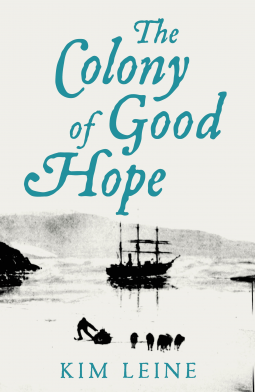
The Colony of Good Hope
by Kim Leine
This title was previously available on NetGalley and is now archived.
Send NetGalley books directly to your Kindle or Kindle app
1
To read on a Kindle or Kindle app, please add kindle@netgalley.com as an approved email address to receive files in your Amazon account. Click here for step-by-step instructions.
2
Also find your Kindle email address within your Amazon account, and enter it here.
Pub Date 31 Mar 2022 | Archive Date 31 Mar 2022
Pan Macmillan | Picador
Talking about this book? Use #TheColonyofGoodHope #NetGalley. More hashtag tips!
Description
'A Scandinavian literary figure without precedent.' - Guardian
In the tradition of Conrad’s Heart of Darkness, an immensely powerful historical novel about the first encounters between Danish colonists and Greenlanders in the early eighteenth century, of brutal clashes between priests and pagans and the forces that drive each individual towards darkness or light.
1728: The Danish King Fredrik IV sends a governor to Greenland to establish a colony, in the hopes of exploiting the country’s allegedly vast natural resources. A few merchants, a barber-surgeon, two trainee priests, a blacksmith, some carpenters and soldiers and a dozen hastily married couples go with him.
The missionary priest Hans Egede has already been in Greenland for several years when the new colonists arrive. He has established a mission there, but the converts are few. Among those most hostile to Egede is the shaman Aappaluttoq, whose own son was taken by the priest and raised in the Christian faith as his own. Thus the great rift between two men, and two ways of life, is born.
The newly arrived couples – men and women plucked from prison – quickly sink into a life of almost complete dissolution, and soon unsanitary conditions, illness and death bring the colony to its knees. Through the starvation and the epidemics that beset the colony, Egede remains steadfast in his determination – willing to sacrifice even those he loves for the sake of his mission.
In The Colony of Good Hope, Kim Leine explores what happens when two cultures confront one another. In a distant colony, under the harshest conditions, the overwhelming forces of nature meet the vices of man.
Translated from the Danish by Martin Aitken.
Available Editions
| EDITION | Other Format |
| ISBN | 9781529014334 |
| PRICE | £18.99 (GBP) |
| PAGES | 576 |
Featured Reviews
 Educator 503968
Educator 503968
The Colony of Good Hope is a story based on fact: the attempt by Denmark, in the 1720s, to establish a colony in Greenland and to make Christians of the indigenous people.
I chose this book as I enjoy reading fiction that gives an insight into other countries and their histories and cultures and provides you with different perspectives on the world. In this case, I knew very little about Danish history and nothing at all about that of Greenland. Reading "The Colony of Good Hope " has decreased my ignorance a little: however the author warns, in his afterword, that “this book is a fiction … it runs closer to actual historical events than its predecessor but it should not be read as a reliable historical account”.
The words “its predecessor” give away the fact that this is the second book in a trilogy: I wasn’t aware of this until reaching the end of the book and it stands alone perfectly well.
Leine marshals a large cast of characters, most of whom (again, quoting from the afterword) “were real people and appear under their own names. While I have made use of their biographies … I have taken considerable liberties with them”.
These characters range from the king of Denmark, through the group of convicts and sex workers who are conscripted to provide the labour force and form the backbone of the colony, to the indigenous Greenlanders. The narrative is divided between an omniscient narrator and a variety of these characters, including a ship’s captain; a surgeon; the governor’s mentally-ill housekeeper (whose stream-of-consciousness ramblings make her the most challenging of the narrators to read); Appaluttoq the shaman and Katerina, a Greenlander who has become a devout Christian. While it can take time to get into each new narrator, this technique allows you to get inside the characters and to see the various personages from different perspectives.
The title refers to the name of the colony “Godthåb”: however, the original Danish title translates as “Red Man, Black Man”. The “red man” is Appaluttoq, whose words open the novel; the “black man” is the Lutheran minister, Hans Egede. The two are locked in a continual struggle, and not just for the souls of the Greenlanders. However, although the English title is very different and comparatively literal it is not a bad one. Hope is endemic among the settlers – hope of wealth, power, success, attaining salvation (and bringing the so-called “heathens” to salvation) or just hope of survival; even the futile hope of the alchemist.
Egede is at the centre of the book, as he is at the centre of the colony. A severe and unbending clergyman, a devout and uncompromising Lutheran, hot-tempered, feared by his family and mostly unsuccessful in his efforts to convert the Greenlanders to Christianity – something he is himself so aware of that he is reluctant to baptise any of them, knowing that they are not truly convinced by his preaching. Egede is seen through the eyes of the various narrators and is presented as a complex character, and one for whom we can even feel sympathy, rather than merely a stereotyped man of religion.
The book requires a strong stomach in places: there are visceral accounts of a post-mortem, childbirth, a mastectomy and the effects of a smallpox epidemic as well as a character with Ozzy Ozbourne tendencies. The descriptions of the colony and the Greenlanders’ dwellings use smell as much as they do sight.
Translator Martin Aitken skilfully conveys the various voices and a sense of the language and idiom of the 1700s.
“The Colony of Good Hope” is a slow burn, not conventionally dramatic and potentially dramatic incidents are often downplayed. Even so, it draws the reader in and while it is not always an easy read it is certainly a rewarding one.
















